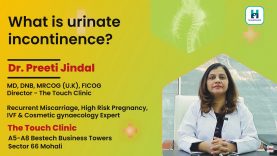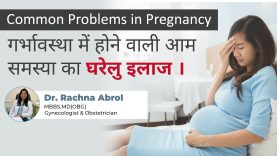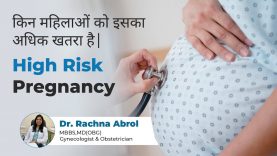What is High-Risk Pregnancy? How is it managed? By Dr. Rachna Abrol
- 3.03K
- 3 months from now
Dr. Rachna Abrol
Dr. Rachna Abrol
What is High-Risk Pregnancy? How is it managed? By Dr. Rachna Abrol
In this video, SimpliHealth expert Dr. Rachna Abrol, Consultant Obstetrician and Gynecologist practicing at Mediclinic, Sector 22, Chandigarh, is discussing High-Risk Pregnancies.
What is High-Risk Pregnancy?
Any pregnancy that poses a threat to either the baby or mother or has few complications associated and the risk factors involved.
It is important to identify or diagnose high-risk pregnancies because once we diagnose, we can monitor the baby and mother and start their treatment accordingly.
What are the common problems that we consider in high-risk pregnancy?
High blood pressure
One is high blood pressure. if the mother’s blood pressure is high, it could have been before pregnancy or commenced after pregnancy. Under these circumstances, the first thing is that we need to control the mother’s blood pressure, and the other thing is high blood pressure affects the fetus’s growth.
It is very important to control the blood pressure of the mother by regular check-ups and we must keep it under control. And if the mother’s blood pressure is high then we can treat both mother and baby simultaneously.
Blood sugar
Another complication in pregnant women is increased blood sugar levels in mothers, more appropriately called gestational diabetes in which there is an increase in sugar level, especially during pregnancy.
When there is an increase in the blood sugar level during pregnancy, then it affects both the mother and the baby. So it is very necessary to control blood sugar levels.
First, we suggest a diet to control the sugar, but if the diet isn’t helpful then we may start insulin. By following these procedures, we control blood sugar levels.
Anemia
Another common complication often seen in high-risk pregnancy is anemia or low hemoglobin levels in the mother. If the mother’s hemoglobin is less then we need to supplement iron, and if it doesn’t help, we might transfuse the blood.
It is required because if the mother is anemic, it would undoubtedly affect the baby’s growth; the baby will be very weak.
Mother’s Age
If the mother’s age is more than 35 years at the time of pregnancy, then we classify the pregnancy as a high-risk pregnancy. Because with advancing age, the mother might face more problems, and the baby is at high risk of having chromosomal abnormalities. So we categorize elderly gravida as a high-risk pregnancy.
Placenta Previa
Another high-risk pregnancy is placenta previa, in which the placenta is positioned downwards. Due to its position, there are chances of on and off bleeding during pregnancy. This might result in early delivery before time or preterm delivery. These are a few conditions that we consider high-risk pregnancies, so it is essential to identify high-risk pregnancies.
High-Risk Pregnancy Management
- Why is it important to identify high-risk pregnancy and their management?
- What is our aim in High-risk Pregnancy Management?
Our main goal is to have a healthy mother and a healthy baby. We monitor all the parameters during pregnancy and we always expect that the pregnancy will complete its full term as it should go till nine months.
However, in a few cases, we need to terminate the pregnancy early; we need to deliver the baby early. We take the decision of early delivery of a child when we see any complication which is bringing a threat to either mother or baby.
Our main way of managing any pregnancy whether it is High-risk or normal pregnancy is to have a healthy mother and a healthy baby. We require excessive monitoring in High-Risk Pregnancy because we need to find an appropriate time for delivery. Often when we see the mother or the baby is getting affected, baby growth is less or the fluid around is visible less during the Ultrasound or the baby might have some problems staying inside the womb then we might deliver the baby early.
Bleeding or Spotting During Pregnancy
Often ladies have bleeding and spotting during pregnancy so this is also one of the high-risk factors. They may be suffering from placenta previa. Placenta previa is a condition in which the placenta is positioned closed towards the uterus and this may lead to excessive resulting in preterm or early delivery.
The mother may have heavy bleeding and the baby will be delivered early. This is one of the high-risk factors and we do consider it in high-risk pregnancy. We diagnose this condition by ultrasound. If any mother has placenta previa, then we need to monitor her very closely.
Management and monitoring
A few mothers have an age of above 35 years during pregnancy then we classify them as a high-risk pregnancy. The mother also has to suffer from other age-related problems and the baby may develop chromosomal abnormalities. Therefore we must monitor them intensively.
Accordingly, we need to manage them; we need to perform more tests and they require a little extensive monitoring. Our main aim of Management in High-risk pregnancy is that we deliver the baby at the right time.
Our main aim in the Management and monitoring of High-risk pregnancy is a healthy mother and healthy baby. We do take care of mother and children well, their treatment is optimized so that our mother doesn’t have any problems and our baby is also healthy.
Wishing you a very healthy and happy pregnancy. Thank you.















Comments (0)